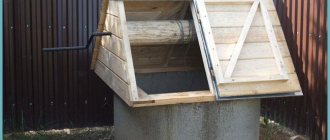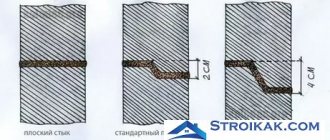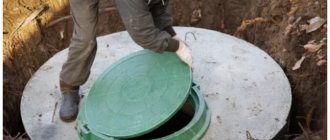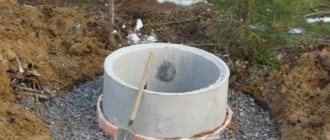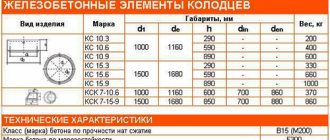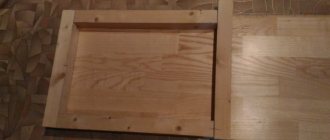Well rings
Concrete rings are a very popular product used for the construction of hydraulic and sewerage structures. Moreover, the demand exists not only from large construction companies, but also from private owners and individual developers who want to provide themselves with a comfortable life. To manufacture these products, special molds are used for the production of well rings, produced by industry in accordance with the standards that regulate their sizes (GOST 8020-90).
Purpose and design of concrete rings
Reinforced concrete rings are used during engineering and technical work at construction sites. The products are widely used in the installation of autonomous sewage systems: inspection and filtration wells, septic tanks. They can be found when equipping city roads, bridges, highways, landscape design objects and wastewater treatment plants.
Reinforced concrete rings
Information. Standards for the production of reinforced concrete rings are regulated by GOST 8020-90.
The strength and durability of the structure allows them to be installed in wells for water extraction.
There are several types of products:
- flat end rings;
- rings with a locking end;
- repair;
- supporting
Characteristics of rings with a lock
For the construction of wells, products marked KS - wall ring are used. Concrete rings with a lock are a structure that has recesses in the end part. The function of the lock is to prevent the rings from shifting under soil pressure and to ensure tightness.
Attention. Reinforced concrete rings with a flat end can shift under the influence of quicksand, blocking up to 40% of the well shaft.
Characteristics of standard rings
Well rings are a cylindrical structure with a frame made of metal reinforcement. For the production of elements, concrete of a grade not lower than M200 is used. The demand for products is explained by their positive qualities:
- strength - the material does not collapse under the influence of moisture and loads;
- durability, service life is 50 years;
- environmental safety, concrete does not have a negative effect on water;
- tightness of the structure - a well-formed structure does not allow moisture to pass through.
Ring design
Types of reinforced concrete modules
The simplest standard models are produced without additional fasteners. Their end resembles a smooth, even rim both at the top and at the bottom.
When laying, they are placed one on top of the other and fastened with metal brackets. The joint area is covered with cement mortar or dry repair mixture.
A hydraulic seal can be used as a sealant for well rings. The material consists of a special grade of cement and quartz sand. It hardens quickly and expands over time. Protects reinforced concrete mains from sewage penetration
After such treatment, the system acquires optimal integrity and tightness. Correct insulation in the contact area of concrete elements extends the operational life of the shaft and almost completely eliminates water leakage through the cracks between concrete elements.
Despite their reliability and strength, standard rings without a lock are suitable for installation in regions with low seismic activity. Strong ground movements can lead to displacement of modules and cracking of cement in the joint area
Euro-rings are available with a practical milling-type locking connection. There are protrusions at the top of such products, and deep recesses at the bottom.
During installation, the elements are inserted into each other, thus providing a monolithic and strong connection that does not require additional processing in the joining area.
When purchasing well rings with an end lock, you should carefully monitor their quality. Poorly cast joining parts will complicate the work and require the use of diamond cutting to eliminate errors and imperfections
This facilitates and speeds up the process of creating a communication system and reduces the overall financial costs of the project. A well shaft made of Euro-rings with a lock is not afraid of seismic activity with shears and maintains the integrity of the structure even on very unstable soils prone to subsidence.
A monolithic glass is a one-piece structure made of a row ring and a bottom. Used in places with increased requirements for tightness, for example, for sewer tanks. Provides a high level of protection to the surrounding soil and does not allow the contents of the well to seep into the ground or enter groundwater.
Production of well rings in 2022
Self-production of concrete rings in 2022 will be economically justified if about 10 products are required for construction. The cost of producing concrete structures is significantly lower than their retail cost, even taking into account the fact that molds will have to be made to make well rings. And if you include the money saved on delivery, then the last doubts about the feasibility of the process will disappear.
Factory bench well rings are made using the vibration molding method. This means that the concrete solution is placed in a special form and compacted using vibration. Without this process, high strength cannot be achieved. A mixture of concrete and fillers is prepared directly at the work site.
The factory vibroform consists of two metal cylinders of different diameters. The outer part, reinforced with stiffening ribs, has a fixed vibration mechanism with an electric motor. The unit helps compact the concrete mixture. A cone is welded to the inner ring, acting as a lid. The equipment is highly productive, but also costs a lot. If making well rings is a one-time event, then there is no point in buying equipment; it is better to do it yourself.
Factory ring mold
Advice. When purchasing a factory-made mold, pay attention not only to the dimensions, but also to possible modifications: the manufacture of transportation loops or through eyes. The durability of the product and the accuracy of the geometric dimensions of the produced rings depend on the thickness of the metal of the cylinders.
Formwork for well rings is divided into external and internal. The distance between the parts will be the thickness of the walls. Their size is determined by the diameter of the products:
- 70 cm – 7 cm, without reinforcement – 12 cm;
- 100 cm – 8 cm, without frame – 14 cm.
Attention. To manufacture products with a lock on the end, a more complex shape will be required.
Standard components include a lid and a bottom. Their sizes correspond to the diameter of the rings.
Wire frame for reinforcing rings
Concrete ring with eyes
The standard form for reinforced concrete rings involves creating products with lugs. This method is described in detail in GOST. Openings are placed at opposite points on the side surface of the mold to create holes for fastening the slings and moving the finished rings. If this is not necessary, then plugs are made.
In a mold made without openings, the rings are lifted using metal loops connected to a reinforcing frame. However, if you buy this type of vibration mold to make a well ring, then it is important to understand that in this case it will not be possible to make a lock product.
Size range of products
Reinforced concrete rings used for the installation of inspection, sewer and water supply wells have several basic parameters: diameter, height, wall thickness. Classifying the sizes of reinforced concrete rings for a well, they can be divided into 3 groups:
- Large - products with a diameter of 2 m, weight up to 2.3 tons, height up to 90 cm
- Medium - internal cross-section 1.5 m, weight - 0.9-1.3 t, height up to 90 cm.
- Small – diameter – 1 m, weight 600 kg, height up to 90 cm.
These are popular sizes of well rings; if necessary, you can purchase or manufacture additional elements of any height and diameter, depending on individual needs. The strength of products depends on the thickness of their walls and the presence of a reinforcement cage. When choosing a parameter, take into account the type of soil, its tendency to compression and frost heaving.
Information. Products are marked with the internal diameter of the rings in decimeters.
Preparation of rigid concrete mixture
Rigid concrete mixture Zh-3 is used to form well rings. Concrete class B15 (Grade M200). The composition of the mixture must be selected by a concrete production technologist. Approximate ratio per 1 cubic meter of finished mixture:
- cement PC500D0 – 230 kg:
- sand with a particle size modulus of 1.5-2.3 (medium grain size) - 900 kg;
- crushed stone fraction 5-10 mm - 1100 kg;
- plasticizer S-3 - 1.6 kg;
- water - 120 liters (with sand humidity 4%)
If the sand is wet, the amount of water must be reduced.
Making a mold for rings with your own hands
Materials
What materials can formwork be made from? Any available materials strong enough to make several products will do:
- boards;
- sheets or metal products;
- plastic.
Wooden formwork
Metal forms will be the most reliable and durable option; such formwork can be rented out in the future. The use of barrels or pipes of the appropriate diameter will simplify production. Welding individual sheets and then bending them takes more time and requires physical effort.
Homemade mold from metal sheets
Advice. Plastic cylinders are also an acceptable option, especially since polymer containers are sold in all sizes.
Technology
A metal mold for the production of well rings, the material for which is two barrels of different diameters, is constructed using a simple technology:
- The bottom of both barrels is cut off.
- Vertical markings are applied to the inside and outside of the larger product, dividing it into two equal parts.
- Using a welding machine or rivets, metal corners are attached to the outside of the cylinder. They are located along the entire marking line or in three pairs: at the top, in the middle and at the bottom. The elements must be located exactly opposite each other.
- Holes are drilled in the corners for bolts that will be used to secure the form.
- The barrel is cut with a grinder from the inside; you should work carefully so as not to touch the welded fastening parts.
- The next stage is preparing the inner cylinder. A smaller barrel is also marked with vertical lines.
- According to the markings, corners are welded for subsequent connection of parts. In this case, they are placed on the inside of the cylinder.
- The barrel is cut from the outside.
- For convenience, handles are welded to the cylinders - to the outside from the outside, to the inside - from the inside.
Attention. The inner cylinder is divided into one and two thirds; the smaller part can be easily removed inside when dismantling the formwork.
When making a well ring with your own hands, you must not forget about the elements for moving it. These can be metal mounting loops connected to a reinforcement frame or through holes. The second option is more acceptable, because when installing wells, the hinges have to be cut off. To make eyelets for the slings, holes are cut in the mold and wooden round blocks 4-5 cm thick are inserted.
Preparation of concrete solution
In order for the concrete to be of high quality, it is necessary to follow the recommended proportions of ingredients. The calculation of shares is carried out based on the base - cement:
- sand 2:1;
- gravel 3:1, 4:1;
- water – 0.5-0.7.
The gravel is pre-soaked in water. Sand and cement are mixed first, then water is added. After mixing the solution, add gravel.
Advice. The brand of concrete used affects the strength and durability of the products, so you should not skimp on the components of the solution.
The production site is located away from sunlight, under a canopy. Rapid drying of moisture from concrete reduces its strength. It is better to work on making rings for a well of any diameter at a temperature not lower than +80.
Concrete mixer for mortar
Advantages and disadvantages of reinforced concrete products
Well rings made of reinforced concrete are very popular and are included in the list of the most popular building materials. This is due to their specific physical and structural characteristics.
The main advantages of the product include:
- Extended operational period. Concrete reinforced with steel wire is neutral to any environment, including aggressive ones, and, according to manufacturers, can last at least 100 years.
- Maintaining rigidity and structural integrity on active soils. Wells made of reinforced concrete rings are installed even in areas with seismic activity up to 8 points.
- Wide range of models . Products are available in a variety of sizes. This makes it possible to select suitable reinforced concrete products for any purpose and need.
- Pronounced frost resistance. It is ensured by a strong bond between the reinforcing elements and the concrete mixture, which occurs after the final drying of the workpiece.
- High tightness. The seams fit tightly together at the joints and prevent the penetration of groundwater and other foreign substances or materials.
Finished products are sold at the best price and are suitable for arranging communication networks of any scale.
In the process of producing a well from reinforced concrete rings, it is necessary to strictly adhere to the installation rules. Incorrect installation will lead to uneven load on the walls and in the future will provoke the appearance of cracks throughout the pipeline
Disadvantages include the weight and dimensions of the product. Transportation and installation require professional equipment with good power and a team of craftsmen.
This inevitably entails additional material costs and an increase in the total cost of installation work.
You can make reinforced concrete rings for installing a small well in your country house with your own hands. The homemade production technology is described in detail in the following article, which we highly recommend reading.
List of required equipment
Work on the production of concrete rings is carried out on a spacious construction site. The list of mandatory equipment and necessary devices can include:
- concrete mixer (shovels and a metal sheet on which the concrete solution is manually mixed);
- blanks for rings (special forms);
- vibrator;
- lifting devices, since the weight of one reinforced concrete ring for a well can reach 500 kg or more;
- reinforced frame (you can purchase ready-made or weave it yourself from wire).


